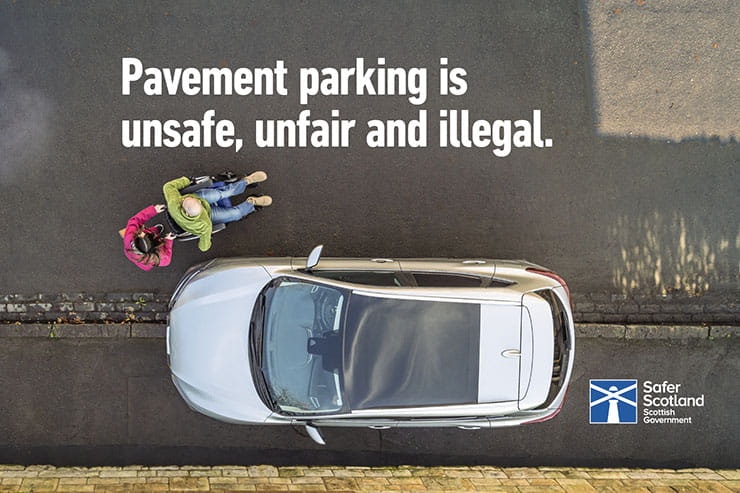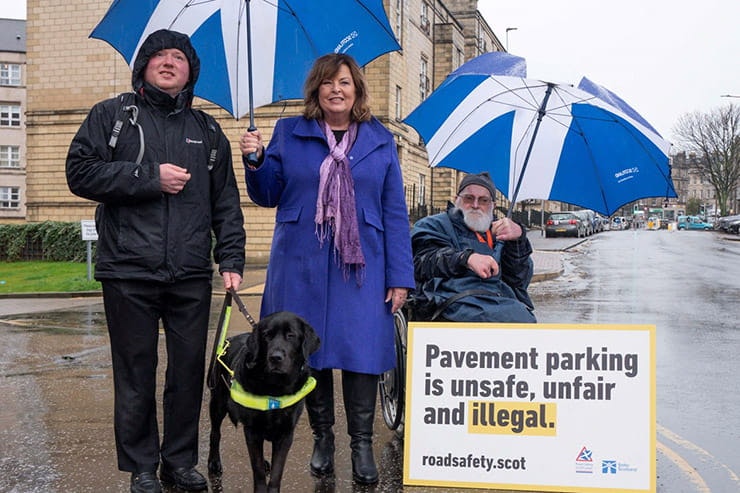Scotland pavement parking ban in force from this week – and it’s likely to spread to England in future
By Ben Purvis
Motorcycle Journalist
14.12.2023
Above: Transport Scotland’s message, and Fiona Hislop, Minister for Transport
Scotland’s long-mooted ban on pavement parking – impacting all motor vehicles including motorcycles – finally came into force this week and the Government in Westminster is likely to be looking on with interest as to its results with an eye to bringing in similar legislation in England.
The Scottish pavement parking ban was inked into the Transport (Scotland) Act 2019, so its implementation has been on the way for the last four years, but even so it’s being accompanied by an advertising campaign to ensure people know about it. From 11 December, the Act says: “A person must not park a motor vehicle on a pavement” and explains that a vehicle – including a motorcycle – is considered to be parked on pavement if it is stationary and “one or more of its wheels (or any part of them) is on any part of the pavement”.
It makes no difference whether you’re with the vehicle or not, or whether the engine is running. Come to a halt on a pavement and you can be slapped with a £100 fine. It’s already illegal to drive on pavements across the UK, but it’s a law that’s rarely enforced when it comes to parking.
In Scotland the introduction of a specific piece of legislation against pavement parking, and the establishment of that £100 penalty (reduced to £50 if paid within 14 days), eliminates any ambiguity and means that, outside of a few specific exemptions, drivers and riders who leave their cars or bike on the footpath can expect a ticket.
The exemptions in the legislation include police vehicles, ambulances and fire engines as well as vehicles used for military purposes where their work would be hindered if they didn’t park on the pavement, and even then they have to leave at least 1.5 metres of clear pavement. Other exemption are vehicles being used for roadworks, waste collection, postal work or some other professions – medics, midwives, registered nurses – but only when there’s no reasonable alternative, for as brief a time as possible and again leaving 1.5 metres clear. Deliveries and collections in the course of business also get a pass, provided they take no longer than 20 minutes, and there are also get-outs for breakdowns and emergencies .
The same new law also introduces a £100 penalty for parking by dropped kerbs where they’re used for pedestrians or cyclists (you can still park in front of kerbs dropped for driveways or garages), and for double-parking.
You might be sitting in England thinking that all this is irrelevant to you, and at the moment that’s still the case in most of the country – although in London pavement parking has been banned since 1974. However, a 2019 report by the House of Commons Transport Committee, published in March 2020, leaves no doubt that the same ideas being implemented now in Scotland are firmly on the radar for the rest of the country as well, concluding: “We recommend that, in the long term, the Government legislate for a nationwide ban on pavement parking across England…”
Even in the announcement of the Scottish ban there’s an implication that it’s expected to expand, with Minister for Transport Fiona Hyslop saying: “Scotland is the first of the four nations to make pavement parking illegal nationwide. This change in legislation is a step towards developing communities that are better able to support active travel, building on the work that is already underway to reduce emissions and helping us meet our world-leading climate change targets.”
If you’d like to chat about this article or anything else biking related, join us and thousands of other riders at the Bennetts BikeSocial Facebook page.
Share on social media:

